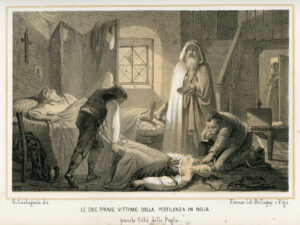
The last outbreak of the Plague on the Western European mainland occurred in 1815 in a town called Noja (present Noicattaro), on the Apulian coast of Italy.
Liborio Didonna, a gardener, was the first person who died from the contagion, two days after he showed the first symptoms, his wife Pasqua Capella succumbed two days later. When they were buried, their cause of death was still unknown, so no precautions were made, and their belongings found their way to several relatives.
When after a month the severity of the disease was identified, a very strict cordon sanitaire was imposed, consisting of three trenches guarded by armed forces, which lasted a year.
Between 700 – 800 inhabitants (about one seventh of the population) died, while 700 other patients recovered.
Lithograph by G. Castagnola / Ballagny e Figli


